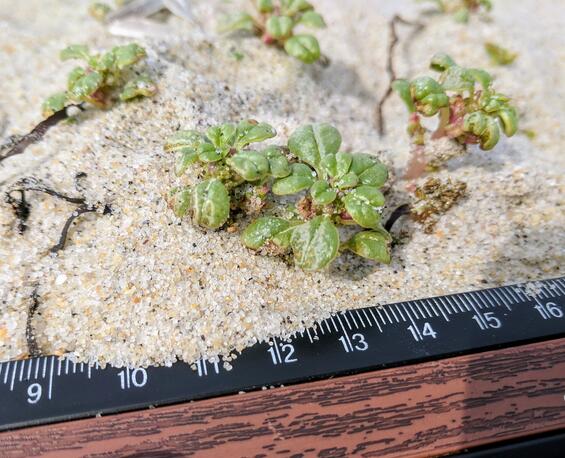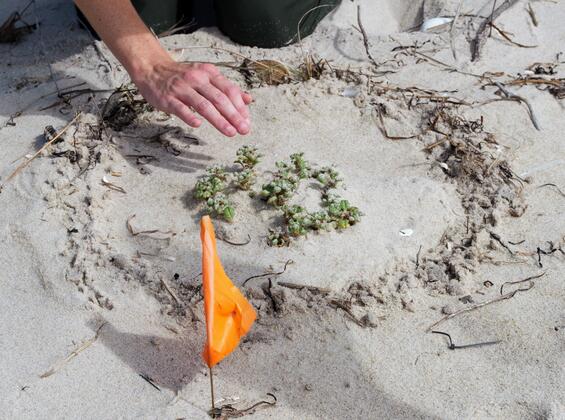- Scientific name: Amaranthus pumilus Raf.
- Species of Greatest Conservation Need (MA State Wildlife Action Plan)
- Threatened (US Endangered Species Act)
Description

Image Credit: Robert Wernerehl
In appearance, when mature, seabeach amaranth looks like a diminutive cross between garden beets, chard and spinach. Not surprisingly, these are all members of the same plant family, the Amaranth family or Amaranthaceae. In fact, there is a garden beet subspecies called sea beet, (Beta vulgaris subsp. maritima) that in England occupies nearly the same seashore habitat as seabeach amaranth.
Seabeach amaranth is an annual plant that exhibits low, relatively prostrate growth with fleshy, rounded, dark green leaves clustered near the tips of fleshy, reddish stems. Plants germinate from April to July, initially forming a small sprig but soon branch and form a clump which binds sand that accumulates at its base. Larger plants may contain over one hundred stems which branch from the center and attain a diameter of over a meter, although plants are typically 20-40 cm (~8-15 in) in diameter. Flowering begins in June with seed production in July and until senescence in early winter. Plants are monoecious (having separate male and female flowers on the same plant). The inconspicuous yellow flowers are borne in the leaf axils and are wind pollinated. The species is a prolific seed producer, and the waxy seed are relatively large (2-2.5mm [0.08-0.1 in]) and are believed to be viable for long periods. Seed dispersal may occur by wind, water and possibly birds, and whole plants and seed are temporarily buoyant. The life history of this plant, combined with the dynamic coastal habitat within which it evolved, give this species the ability to move within the coastal landscape as a fugitive species, colonizing habitat as it becomes available in both space and time.
Life cycle and behavior
This is an herbaceous annual species that requires shifting beach sands.
Population status

Image Credit: Robert Wernerehl
Seabeach amaranth hasn’t been reported in Massachusetts for over 100 years. There are several historic reports of seabeach amaranth from Massachusetts and Rhode Island. Herbarium specimens document collections from Martha’s Vineyard, Duke County, MA (pre-1840) and Nantucket, Nantucket County, MA in 1849. The species was reported from Newport County, RI in 1856. Despite some recent surveys, Seabeach amaranth has not been found on Massachusetts beaches. Rangewide, the species has rapidly declined from over 200,000 plants recorded each year between 2000 and 2002 to only 1,320 plants in 2013, a 99.5 percent reduction.
Bruce Sorrie, the first state botanist in the MassWildlife’s Natural Heritage and Endangered Species Program, looked specifically for seabeach amaranth “a number of times” (Koch 2017) including in large areas of Nantucket and Muskeget Island and Martha's Vineyard but never found plants. Robert Wernerehl, the state botanist at the time, did an extensive search for seabeach amaranth in 2015 on Nantucket’s Great Point. This survey included several trained interns, lasted a full day, and covered seven miles of beach. In addition, Dr. Wernerehl, Mike Kunz (North Carolina Botanic Garden) and Dale Suiter (USFWS) surveyed several areas of suitable habitat in September 2016 and no amaranth plants were found.
In 2017, a joint reintroduction effort between MassWildlife, United States Fish and Wildlife Services and North Carolina Botanic Garden planted three locations with seeds including in Chatham and Nantucket. However, powerful storms with hurricane-force winds in January and early March of 2018 resulted in significant shoreline damage to the state. Few of the plants survived the storms and none were found in 2019.
Distribution and abundance
Seabeach amaranth (Amaranthus pumilus) is a federally threatened and globally rare (G2, NatureServe 2025) species endemic to the Atlantic coast from South Carolina to Massachusetts. Populations on Long Island are currently the northernmost extant populations. It is state historic in Connecticut, Massachusetts, and Rhode Island (NatureServe 2025), endemic to the Atlantic coast from South Carolina to Massachusetts. It is ranked critically imperiled in Delaware, Maryland, New Jersey, North and South Carolina and Virginia. It is ranked imperiled in New York due to recent recovery of populations on the eastern parts of Long Island.
Habitat
In other states, plants occur on barrier island beaches between the foredune and the wrack line and also on open overwash areas behind the foredune. Beaches are usually over 20 meters (65 ft) wide and protected from foot traffic and vehicles (Ring 2011). Plants have also recently been found in beach replenishment areas. Additional plant species associated with this habitat include American beachgrass (Ammophila breviligulata), sea rocket (Cakile edentula), Russian thistle (Salsola kali), seaside spurge (Chamaesyce polygonifolia), seabeach sandwort (Honckenya peploides), seabeach knotweed (Polygonum glaucum), seabeach purslane (Sesuvium maritimum) and seabeach orach (Atriplex arenaria).
Healthy habitats are vital for supporting native wildlife and plants. Explore habitats and learn about conservation and restoration in Massachusetts.
Threats
This annual plant species is vulnerable to climate change, sea level rise, development of beachfront property and increased beach use such as foot and vehicular traffic. In Massachusetts, one of the primary threats to reestablishment of populations is beach driving. Miles of beaches are open to driving and receive heavy use for both general recreational or fishing purposes, either all year or seasonally. Two of these incude Coskata-Coatue and Great Point beach on Nantucket, and Race Point in Provincetown. This use also threatens other shore dwelling plants and animals including migrating shorebirds, insects and unique plant species highly adapted to the salt spray. Deer browse is also a threat. On Fire Island National Wildlife Refuge on Long Island, deer have been observed walking along the beach and pulling up mature seabeach amaranth plants and consuming them entirely. The refuge staff has to protect plants by fencing each one individually. Two of the best islands for habitat, Martha’s Vineyard and Nantucket, have extremely high deer densities which would threaten any newly established plants on these beaches. Other threats include beach raking, construction of sea walls, dune fencing, development, and the natural succession of dune grasses.
Conservation
More survey is needed. New occurrences are best sought during September and October. Additionally, identification training for all the paid and volunteer staff who protect beach nesting bird species may result in new finds for seabeach amaranth, especially given the precisely shared habitat and relative ease of identification. The species is surveyed annually in other states where it occurs.
Perhaps surprisingly, despite the current threats, beach protection during nesting season of the state’s strong populations of piping plover (Charadrius melodus) has created significant areas of potential habitat for seabeach amaranth with the use of symbolic fencing. In other states, this had led to increased populations of seabeach amaranth and it may have the same effect in Massachusetts. Another reintroduction attempt should be made if seeds can be gathered from larger populations on Long Island.
As this plant is under-surveyed, more standard information is needed such as lists of associated species, comments on habitat quality and threats, and assessments of soil conditions and phenology. Research is needed to determine whether this plant can be grown in a nursery or garden setting for purposes of reintroductions. If habitat degradation accelerates losses of current populations, this strategy could prove useful to long-term conservation of this species.
References
Anon. Amaranthus pumilus (sea-side amaranth): Go Botany. Website https://gobotany.nativeplanttrust.org/species/amaranthus/pumilus/ [accessed 6 May 2025].
Anon. Endangered Plants of New Jersey Fact Sheet Amaranthus pumilus Rafinesque. Undated. New Jersey Department of Environmental Protection Division of Parks and Forestry Office of Natural Lands Management P.O. Box 404 Trenton, New Jersey 08625-0404
Anon. 2022. Seabeach Amaranth - A Rare Species on the Move. ArcGIS StoryMaps. Website https://storymaps.arcgis.com/stories/8ef3760b8f46470b91847762f10437af [accessed 6 May 2025].
Baskin, J. M., and C. C. Baskin. 1998. Seed Dormancy and Germination in the Rare Plant Species Amaranthus pumilus. Castanea 63: 493–494.
Clemants, S. Earl. and New York State Museum. 1992. Chenopodiaceae and Amaranthaceae of New York State /. University of the State of New York, State Education Dept., Albany, N.Y. :
Fernald, M. L. 1950. Gray’s Manual of Botany, Eighth (Centennial) Edition—Illustrated. American Book Company, New York.
Gleason, Henry A., and Arthur Cronquist. Manual of Vascular Plants of Northeastern United States
and Adjacent Canada, Second Edition. Bronx, NY: The New York Botanical Garden, 1991.
Haines, A. 2011. Flora Novae Angliae – a Manual for the Identification of Native and Naturalized Higher Vascular Plants of New England. New England Wildflower Society, Yale Univ. Press, New Haven, CT.
Koch, Stephanie. 2017. Application to Reintroduce or Translocate plant species listed under the Massachusetts Endangered Species Act (MESA). Joint project with USFWS and Massachusetts Division of Fisheries and Wildlife.
NatureServe. 2025. NatureServe Network Biodiversity Location Data accessed through NatureServe Explorer [web application]. NatureServe, Arlington, Virginia. Available https://explorer.natureserve.org/. Accessed: 4/11/2025.
U.S. Fish and Wildlife Service. 1993. Endangered and threatened wildlife and plants; determination of seabeach amaranth (Amaranthus pumilus) to be a threatened species. Federal Register 58(65) 18035-18042.
U.S. Fish and Wildlife Service. 1996. Recovery plan for seabeach amaranth (Amaranthus pumilus) Rafinesque. Atlanta, GA. 59 pp.
Contact
| Date published: | May 15, 2025 |
|---|